Nissan CVT Transmission Programming Software Download: Quickly Program Your CVT
Are you looking for a reliable nissan cvt transmission programming software download? This guide walks you through the process, ensuring accurate reprogramming for optimal vehicle performance and longevity, and shows the paramount importance of having the correct calibration files for smooth CVT operation. Let VCCarTool steer you toward efficient solutions that save you time and money.
Click the nissan cvt transmission programming software download link. Contact VCCarTool via WhatsApp: +1 (901) 414 – 1927 if you cannot find the download link below.
1. Understanding Nissan CVT Transmission Programming
Continuously Variable Transmissions (CVTs) offer enhanced fuel efficiency and smooth driving experiences. However, when a CVT is replaced or experiences issues, programming becomes crucial. This process ensures the transmission control module (TCM) accurately communicates with the vehicle’s other systems, optimizing performance. Modern vehicles rely heavily on software, and CVTs are no exception. Proper programming is not just a recommendation; it’s a necessity for vehicle longevity and performance.
1.1. What is CVT Programming and Why is it Important?
CVT programming involves updating or installing software on the transmission control module (TCM). This ensures the TCM correctly interprets sensor data, controls the transmission’s behavior, and communicates with the engine control unit (ECU) and other vehicle systems.
Importance:
- Optimal Performance: Proper programming ensures smooth acceleration, efficient gear ratios, and overall driving comfort.
- Longevity: Correct software minimizes wear and tear on the transmission components, extending its lifespan.
- Diagnostic Accuracy: Up-to-date software provides accurate diagnostic information, aiding in troubleshooting and repairs.
- Fuel Efficiency: Correctly programmed CVTs optimize fuel consumption by maintaining efficient gear ratios.
1.2. Common Scenarios Requiring CVT Programming
Several scenarios necessitate CVT programming:
- Transmission Replacement: When a new or rebuilt CVT is installed, programming is essential to match the transmission to the vehicle.
- TCM Replacement: If the TCM is replaced, the new module must be programmed with the correct software.
- Software Updates: Manufacturers release software updates to address bugs, improve performance, and enhance compatibility with other vehicle systems.
- Performance Tuning: Some enthusiasts reprogram their CVTs to achieve specific performance characteristics, such as quicker acceleration or improved throttle response.
1.3. Potential Issues Arising from Incorrect Programming
Incorrect CVT programming can lead to numerous problems:
- Poor Performance: Jerky acceleration, delayed gear engagement, and reduced power.
- Transmission Damage: Mismatched software can cause undue stress on transmission components, leading to premature failure.
- Diagnostic Errors: Incorrect programming can trigger false error codes, making it difficult to diagnose actual issues.
- Reduced Fuel Efficiency: Inefficient gear ratios can lead to increased fuel consumption.
- Vehicle Inoperability: In severe cases, incorrect programming can render the vehicle undrivable.
2. Essential Tools and Software for Nissan CVT Programming
Having the right tools and software is crucial for successful Nissan CVT programming. This section outlines the essentials, ensuring you’re well-equipped for the task.
2.1. Nissan Consult III Plus: The Go-To Diagnostic Tool
Nissan Consult III Plus is the OEM (Original Equipment Manufacturer) diagnostic tool for Nissan vehicles. It offers comprehensive diagnostic, programming, and reprogramming capabilities.
Key Features:
- ECU Reprogramming: Flash or update ECU software to the latest versions.
- Diagnostic Functions: Read and clear diagnostic trouble codes (DTCs), view live data, and perform active tests.
- Data Logging: Record and analyze vehicle data for troubleshooting and performance analysis.
- User-Friendly Interface: Intuitive interface designed for ease of use.
- Compatibility: Supports a wide range of Nissan vehicles, including those with CVT transmissions.
2.2. Alternative Diagnostic Tools
While Nissan Consult III Plus is the primary tool, several aftermarket options offer similar functionality:
| Tool Name | Description | Key Features |
|---|---|---|
| Autel MaxiSys Series | Comprehensive diagnostic tool with advanced programming capabilities. | Wide vehicle coverage, advanced diagnostics, ECU programming, bi-directional control. |
| Launch X431 Series | Versatile diagnostic tool known for its extensive vehicle coverage and user-friendly interface. | Full system diagnostics, ECU coding, active tests, special functions. |
| Snap-on Solus Series | Professional-grade diagnostic tool with robust features and reliable performance. | Comprehensive diagnostics, live data streaming, bi-directional controls, guided component tests. |
| DrewTech MongoosePro | Pass-thru device that allows you to use OEM software for diagnostics and reprogramming. | Supports multiple OEM software platforms, cost-effective solution for professional technicians. |
| Bosch ESI[tronic] | Diagnostic software and hardware solution with extensive vehicle coverage and technical information. | Vehicle diagnostics, repair information, troubleshooting guides, wiring diagrams. |
| VCCarTool Diagnostic Tool | Tailored diagnostic solutions for Nissan vehicles with comprehensive support. | Specialized Nissan diagnostics, programming, real-time data analysis, user-friendly interface. |
2.3. Software Prerequisites and Compatibility
Before commencing any programming, ensure you have the necessary software and meet compatibility requirements:
- Operating System: Windows 7, 8, or 10 (64-bit recommended).
- Software: Nissan Consult III Plus software or compatible aftermarket software.
- Drivers: Correct drivers for the diagnostic interface.
- Internet Connection: Stable internet connection for software updates and license verification.
- Vehicle Compatibility: Verify that the software supports the specific Nissan model and CVT transmission type.
- VCI (Vehicle Communication Interface): A reliable VCI to interface between your computer and the vehicle’s OBD-II port.
2.4. Obtaining and Installing the Software
- Official Channels: Acquire Nissan Consult III Plus through official Nissan channels or authorized distributors.
- Aftermarket Options: Purchase aftermarket software from reputable vendors.
- Installation: Follow the software vendor’s installation instructions carefully.
- Updates: Keep the software updated to ensure compatibility and access to the latest features.
- License Activation: Activate the software license as per the vendor’s instructions. Contact VCCarTool via WhatsApp: +1 (901) 414 – 1927 for license assistance.
3. Step-by-Step Guide to Nissan CVT Programming
This section provides a comprehensive, step-by-step guide to Nissan CVT programming, ensuring accuracy and efficiency.
3.1. Preparing for the Programming Process
- Vehicle Preparation:
- Ensure the vehicle is parked on a level surface.
- Turn off all accessories (lights, radio, HVAC).
- Connect a battery stabilizer to maintain voltage during programming.
- Software and Hardware Setup:
- Install and update Nissan Consult III Plus or your chosen aftermarket software.
- Connect the VCI to the vehicle’s OBD-II port.
- Verify the VCI is properly connected and recognized by the software.
- Gather Information:
- Vehicle Identification Number (VIN).
- CVT transmission part number.
- Latest software version available for the CVT.
3.2. Connecting to the Vehicle’s TCM
- Launch Software: Open Nissan Consult III Plus or your aftermarket software.
- Select Vehicle: Enter the VIN and select the correct vehicle model and year.
- Initiate Connection: Follow the software prompts to establish a connection with the vehicle’s TCM.
- Verify Connection: Ensure the software confirms a successful connection with the TCM.
3.3. Backing Up Existing TCM Data
- Access TCM Functions: Navigate to the TCM section within the diagnostic software.
- Backup Data: Select the option to back up the existing TCM data.
- Save Backup: Save the backup file to a secure location on your computer. This serves as a safety net in case something goes wrong during programming.
- Verify Backup: Confirm the backup file is saved and accessible.
3.4. Uploading New Software to the TCM
- Select Programming Function: Choose the function for reprogramming or software update.
- Load Software File: Locate and load the new software file into the diagnostic tool.
- Verify File: Ensure the software confirms the file is correct for the vehicle and CVT.
- Initiate Programming: Follow the software prompts to start the programming process.
- Monitor Progress: Closely monitor the progress of the programming, ensuring there are no interruptions.
3.5. Completing and Verifying the Programming Process
- Completion Message: Wait for the software to display a “Programming Complete” message.
- Verification: Perform any verification steps prompted by the software.
- Clear DTCs: Clear any diagnostic trouble codes (DTCs) that may have been set during programming.
- Test Drive: Conduct a test drive to ensure the CVT is functioning correctly and smoothly.
4. Common Errors and Troubleshooting Tips
Even with careful preparation, errors can occur during CVT programming. This section addresses common issues and offers troubleshooting tips.
4.1. Addressing Connection Problems
- Check Cables: Ensure all cables are securely connected.
- Verify VCI: Confirm the VCI is powered on and properly connected to the computer and vehicle.
- Driver Issues: Check and reinstall VCI drivers if necessary.
- Software Compatibility: Ensure the diagnostic software is compatible with the VCI and vehicle.
4.2. Resolving Software Compatibility Issues
- Update Software: Ensure you are using the latest version of the diagnostic software.
- Compatibility Check: Verify the software supports the specific vehicle model and CVT transmission.
- Operating System: Confirm your computer’s operating system meets the software requirements.
4.3. Dealing with Interrupted Programming
- Battery Voltage: Ensure stable battery voltage during programming. Use a battery stabilizer.
- Avoid Interruptions: Minimize any potential interruptions, such as closing unnecessary programs on your computer.
- Restart Process: If interrupted, restart the programming process from the beginning after addressing the cause of the interruption.
- Restore Backup: If the programming fails, restore the TCM data from the backup file created earlier.
4.4. Seeking Professional Assistance
If you encounter persistent issues, consider seeking professional help from a qualified technician. Contact VCCarTool via WhatsApp: +1 (901) 414 – 1927 for expert assistance.
5. Best Practices for Maintaining Your Nissan CVT Transmission
Proper maintenance is crucial for prolonging the life of your Nissan CVT transmission. This section outlines best practices to keep your CVT running smoothly.
5.1. Regular Fluid Checks and Changes
- Frequency: Follow Nissan’s recommended maintenance schedule for CVT fluid checks and changes. Typically, fluid changes are recommended every 30,000 to 60,000 miles, depending on driving conditions.
- Fluid Type: Use only Nissan-approved CVT fluid. Using the wrong fluid can cause serious damage to the transmission.
- Inspection: Regularly check the fluid level and condition. Look for signs of contamination, such as a dark color or burnt smell.
5.2. Avoiding Aggressive Driving Habits
- Smooth Acceleration: Avoid sudden, hard acceleration, as this can put excessive strain on the CVT.
- Gentle Braking: Practice smooth, gradual braking to minimize wear and tear on the transmission.
- Avoid Overloading: Do not overload the vehicle, as this can also strain the CVT.
5.3. Addressing Issues Promptly
- Monitor Performance: Pay attention to any changes in the CVT’s performance, such as jerky shifting or unusual noises.
- Diagnostic Checks: Perform regular diagnostic checks to identify potential issues early.
- Seek Professional Help: If you notice any problems, seek professional help from a qualified technician promptly.
5.4. Benefits of Regular Maintenance
- Extended Lifespan: Regular maintenance can significantly extend the life of your CVT transmission.
- Optimal Performance: Proper maintenance ensures smooth, efficient performance.
- Reduced Repair Costs: Addressing issues early can prevent costly repairs down the road.
- Improved Fuel Efficiency: A well-maintained CVT can help improve fuel efficiency.
6. The Future of CVT Technology and Programming
CVT technology continues to evolve, with manufacturers developing more advanced and efficient transmissions. This section explores the future trends in CVT technology and programming.
6.1. Advancements in CVT Design and Materials
- Improved Belts and Chains: Manufacturers are developing stronger, more durable belts and chains to handle higher torque and improve efficiency.
- Advanced Control Systems: Sophisticated control systems are being implemented to optimize gear ratios and improve driving performance.
- Lightweight Materials: The use of lightweight materials, such as aluminum and composites, is reducing the weight of CVTs, improving fuel efficiency.
6.2. Integration with Hybrid and Electric Vehicles
- Electric CVTs: CVTs are being integrated into hybrid and electric vehicles to optimize efficiency and performance.
- Regenerative Braking: CVTs are being used to enhance regenerative braking systems, capturing energy during deceleration and storing it for later use.
- Seamless Transitions: CVTs are providing seamless transitions between electric and gasoline power in hybrid vehicles.
6.3. Expected Changes in Programming Techniques
- Over-the-Air Updates: Manufacturers are beginning to offer over-the-air (OTA) software updates for CVTs, allowing for remote programming and improvements.
- AI-Driven Optimization: Artificial intelligence (AI) is being used to optimize CVT programming, improving performance and efficiency.
- Enhanced Security: Programming techniques are becoming more secure to prevent unauthorized access and tampering.
7. Case Studies: Successful Nissan CVT Programming
This section presents real-world case studies illustrating the benefits of successful Nissan CVT programming.
7.1. Case Study 1: Restoring Performance in a 2015 Nissan Murano
- Problem: A 2015 Nissan Murano experienced jerky acceleration and reduced power after a CVT replacement.
- Solution: The TCM was reprogrammed using Nissan Consult III Plus with the latest software.
- Outcome: The programming restored smooth acceleration, improved power, and resolved the jerky shifting issue.
7.2. Case Study 2: Resolving Diagnostic Errors in a 2017 Nissan Altima
- Problem: A 2017 Nissan Altima displayed false diagnostic trouble codes (DTCs) related to the CVT after a software update.
- Solution: The TCM was reprogrammed with the correct software version, resolving the compatibility issue.
- Outcome: The false DTCs were cleared, and the vehicle’s diagnostic system returned to normal operation.
7.3. Case Study 3: Improving Fuel Efficiency in a 2019 Nissan Rogue
- Problem: A 2019 Nissan Rogue experienced reduced fuel efficiency due to inefficient gear ratios.
- Solution: The TCM was reprogrammed to optimize gear ratios for improved fuel economy.
- Outcome: The programming resulted in a noticeable improvement in fuel efficiency, saving the driver money on gas.
8. Ethical Considerations in CVT Programming
While CVT programming can offer significant benefits, it’s essential to consider the ethical implications. This section addresses ethical considerations in CVT programming.
8.1. Avoiding Tampering with Safety Systems
- Safety First: Never tamper with safety-critical systems, such as ABS, stability control, or airbags.
- OEM Guidelines: Always follow OEM guidelines and recommendations when programming CVTs.
- Professional Assistance: Seek professional assistance from qualified technicians when dealing with safety-related systems.
8.2. Respecting Intellectual Property Rights
- Licensed Software: Use only licensed software for CVT programming.
- Avoid Piracy: Do not use pirated or illegally obtained software.
- Respect Copyrights: Respect intellectual property rights and avoid unauthorized distribution of software.
8.3. Disclosing Modifications to Customers
- Transparency: Be transparent with customers about any modifications made to their vehicle’s CVT.
- Informed Consent: Obtain informed consent from customers before performing any programming.
- Documentation: Document all modifications and provide customers with a copy of the documentation.
9. FAQs About Nissan CVT Transmission Programming Software Download
Q1: What is Nissan CVT transmission programming?
Nissan CVT transmission programming involves updating or installing software on the transmission control module (TCM) to ensure it communicates correctly with other vehicle systems, optimizing performance and longevity.
Q2: Why is CVT programming important?
Proper CVT programming ensures smooth acceleration, efficient gear ratios, diagnostic accuracy, and optimized fuel efficiency. It also extends the lifespan of the transmission by minimizing wear and tear.
Q3: When is CVT programming required?
CVT programming is typically required when the transmission is replaced, the TCM is replaced, software updates are available, or for performance tuning.
Q4: What tools and software are needed for Nissan CVT programming?
The primary tool is Nissan Consult III Plus, but alternatives like Autel MaxiSys, Launch X431, and Snap-on Solus are also used. Essential software includes the diagnostic software itself, necessary drivers, and a stable internet connection.
Q5: Can incorrect CVT programming cause problems?
Yes, incorrect programming can lead to poor performance, transmission damage, diagnostic errors, reduced fuel efficiency, and even vehicle inoperability.
Q6: How often should I check and change my CVT fluid?
Follow Nissan’s recommended maintenance schedule, typically every 30,000 to 60,000 miles, depending on driving conditions. Use only Nissan-approved CVT fluid.
Q7: What are some common errors during CVT programming?
Common errors include connection problems, software compatibility issues, and interruptions during the programming process.
Q8: What should I do if the programming process is interrupted?
Ensure stable battery voltage, avoid interruptions, and restart the process from the beginning. If the programming fails, restore the TCM data from the backup file.
Q9: Are there any ethical considerations in CVT programming?
Yes, avoid tampering with safety systems, respect intellectual property rights by using licensed software, and always disclose modifications to customers.
Q10: Where can I get help if I encounter issues during CVT programming?
You can seek assistance from qualified technicians or contact VCCarTool via WhatsApp: +1 (901) 414 – 1927 for expert support.
10. Call to Action: Get Expert Assistance from VCCarTool
Navigating Nissan CVT transmission programming can be complex. At VCCarTool, we offer expert assistance to ensure your programming process is smooth and successful. Whether you need help with software, troubleshooting, or tool recommendations, our team is ready to support you.
Benefit from Our Expertise
- Expert Guidance: Our experienced technicians provide step-by-step guidance tailored to your specific needs.
- Software Solutions: We offer reliable software solutions, ensuring compatibility and optimal performance.
- Tool Recommendations: We can recommend the best diagnostic and programming tools for your vehicle.
- Prompt Support: Get quick answers to your questions and resolve issues efficiently.
Contact Us Today
Don’t let CVT programming challenges slow you down. Contact VCCarTool today for expert assistance. Reach out via:
- WhatsApp: +1 (901) 414 – 1927
- Email: mailto:[email protected]
- Website: vccartool.com
Let VCCarTool help you achieve optimal performance and longevity for your Nissan CVT transmission. We are here to assist you with all your diagnostic and programming needs.
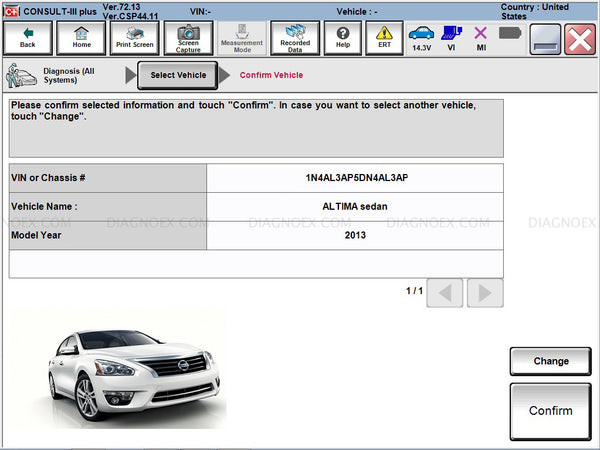 Nissan CVT Programming Software
Nissan CVT Programming Software
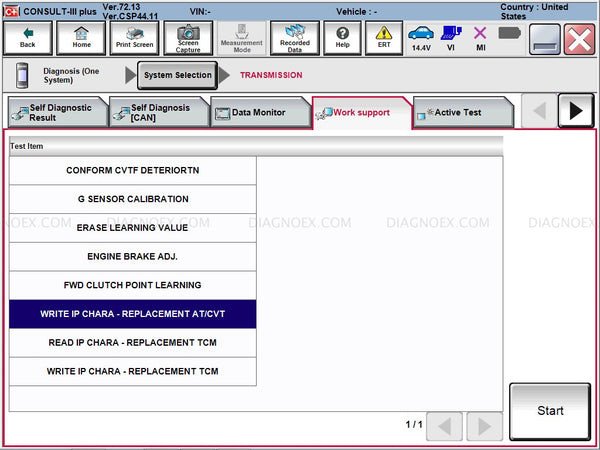 Nissan Consult III Plus Software
Nissan Consult III Plus Software
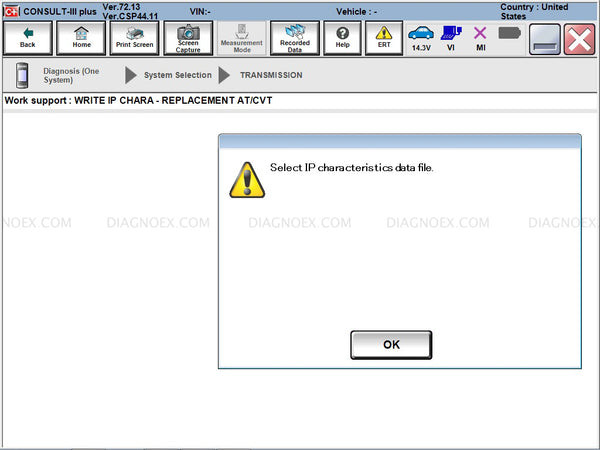 Nissan CVT Programming Process
Nissan CVT Programming Process
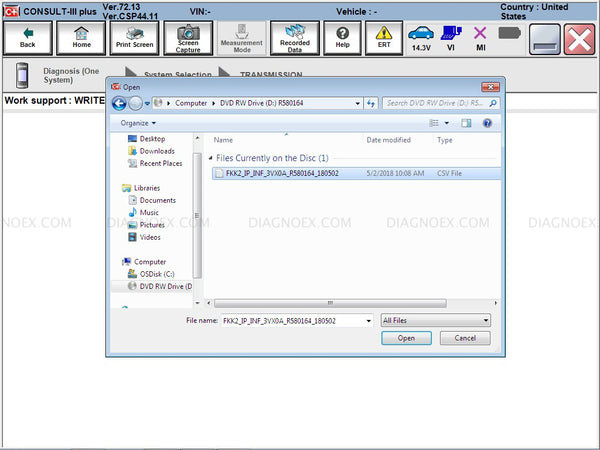 Selecting IP Characteristics Data File
Selecting IP Characteristics Data File
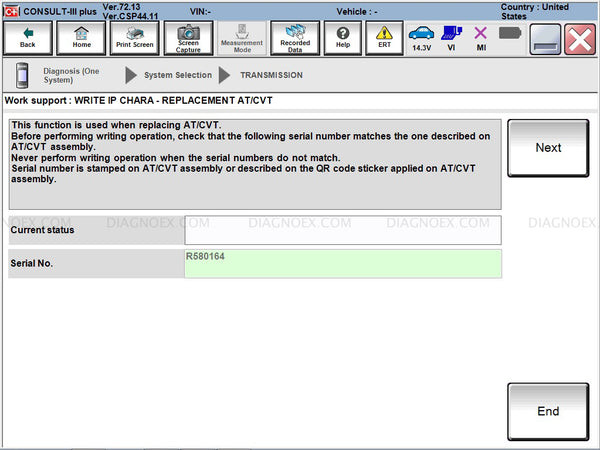 Verify Serial Number on Consult
Verify Serial Number on Consult
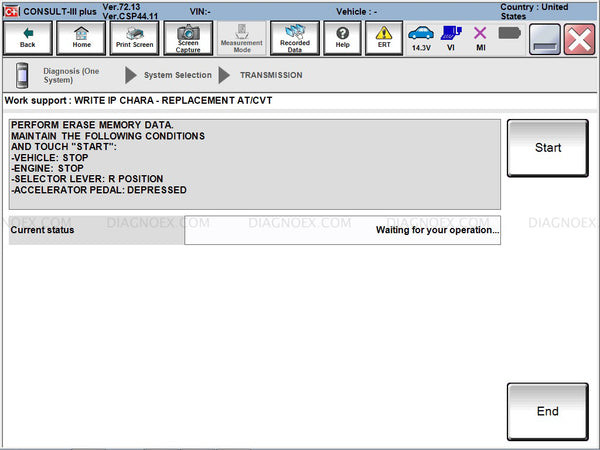 Data Writing Completed Successfully
Data Writing Completed Successfully
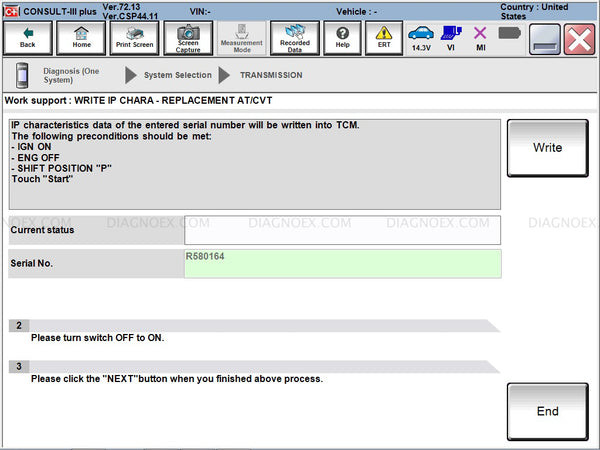 IP Characteristics Data Writing
IP Characteristics Data Writing
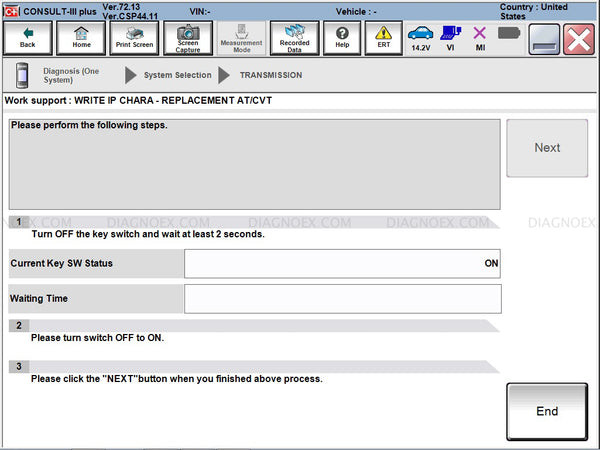 Follow Consult III Plus Screen Guide
Follow Consult III Plus Screen Guide
